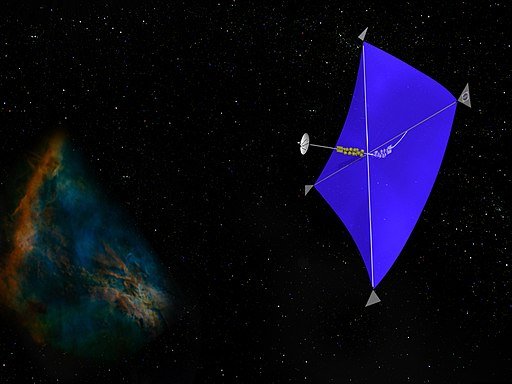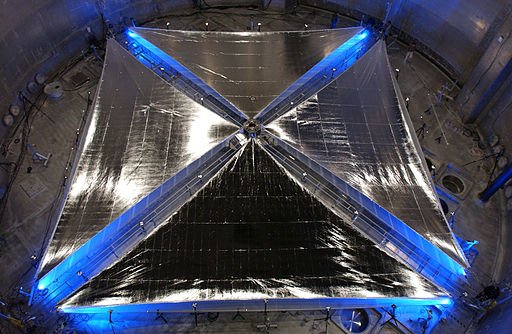Setting Sail in Space - Part 2.
In the last part, we talked about the electric sails. Here is the link.
Today, we talk about the tried and tested, solar sails. Just as in last part, I'll discuss their mechanisms, and possible applications in future. The entire technology of sails in relatively very new, and right now we are only experimenting with these sails to learn more about their workings and hence figure out better ways to use them in the most effective manner.
Now, as most of us already know, solar sails harness their momentum from the photons emitted by sun (i.e. sunlight or solar radiation. All these terms mean the same thing). First, let's see a bit about photons, and how they become the source of momentum for our solar sails.
How Do Photons Give Speed?
Now I have a question. The formula for momentum we commonly use p is p = mv. Where m is mass and v is velocity. And it is a known fact, that photons travel at speed of light (v = c) and have zero rest mass (m = 0). In fact, they are merely packets of energy (hν, where h is Planck’s constant, and ν is frequency of light in Hz or s-1). How come their momentum isn't zero, since that's what we should get if we multiply anything with zero, right? And why doesn’t the same happen to energy when E = mc2 applies for all particles?
Well, relativity changes things a bit. The actual formula for total energy is,
E2 = p2c2 + m02c4
Or also,
E = [p2c2 + m02c4]1/2
Here, c is the speed of light, and m0 is the actual rest mass of the object, or in this case, particle as well as wave.
You see, photon in a light wave is actually its energy. The energy of the wave is transferred only in packets that we call quanta. A single such packet is called a quantum of that energy and is also called a photon. And every such packet of energy, behaves like a particle as well as a wave. Or simply, light travels more like a wave, and transmits its energy more like a particle, thus resulting in a change in momentum.
For photons, m0 = 0. This means E = pc.
Or, p = E/c. This is how we get the momentum of photons, not possible by using the classical p = mv.
Also, for our energy equation, if we consider something at rest relative to us, its relative momentum is zero, and the equation reduces to the more famous E = mc2.
Looking at this a bit closely, we see that, p = hν/c = h/λ. or simply, p changes with 1/λ. The more the wavelength of a light wave, the lower its momentum.
And that's all the complicated theory for today, now to the interesting part... the applications of this theory, The Solar Sail Technology.
How Much Can We Gain??
When light waves strike a surface of any object, and get reflected or absorbed, they impart some of their momentum to that surface. Or we can also say, since momentum of the object changes, and F = dp/dt, some amount of force is applied, in the direction of the wave of course. And this also means there is some pressure given by force /area.
This pressure is called radiation pressure and is significant when we measure the momentum gathered by the solar sail. The radiation pressure, varies with intensity of light, and hence increases as we get closer to the sun. This intensity, since it decreases with distance from sun, solar sails gain lesser accelerations at longer distances. In fact, while travelling to a distant planet, beyond the asteroid belt that comes before Jupiter, solar radiation pressure grows too weak, and solar sail technology fails to gain any significant acceleration.
The plus point here is that we can make the most out of what we have. The e-sail technology we talked about yesterday, can gain an acceleration of 1 mm/s2 derives it's momentum from the pressure from solar wind. If we compare this with radiation pressure (or simply photon pressure) for the same amount of surface area, it is only around 1%. Whereas the latest e-sail with 20 km long wires can accelerate to 1 mm/s2, Let’s see what we gain from a square solar (photon) sail of 1 km side, i.e. 1 km2 surface area…
Now, in terms of numbers, Solar Radiation Pressure for reflection (since we use mirrors in a solar sail), can be given by formula
Preflect = (9.08 / R2) cos2α (in µPa or µN/m2)
Two more formulae we will use are the simple ones:
Pressure = Force / Area,
and Force = mass(m) x accelaration(a) = dp/dt, or change in momentum with respect to time.
Here R is the distance from the sun in terms of AU. 1 AU is the average distance between earth and sun. And, α is the angle between the light waves from sun and the normal drawn to the surface of the mirror.
Calculating for R=1 (at the distance between earth and sun), and α = 0o, we get P = 9.08 µPa. And hence, for 1 km2 are, Force is 9.08 N, and hence, calculating for a mass of 2 tons, we gain the acceleration of about 5 mm/s2. This number is about 9 mm/s2 if the journey starts from Venus, and about 30 mm/s2 in case it starts from Mercury. This is a lot of energy for a good start, plus since we are comparing, the e-sail technology uses less than 1 ton of mass for its calculations, for comparing with voyager spacecraft… yet, the mirror could be heavier than wires... Don’t know this for sure… since we are still working on it.
The first solar sail tested in space was by the JAXA, and is named IKAROS. The sail weighed 315kg, and was 196 m2 in area. NASA’s Nanosail- D2 had, and future ones will have their mirrors merely a few atoms thick. The untested Sunjammer by NASA, spanned to about 1200 m2 (13000 square feet) and weighed less than 180 kg (<400 pounds).
Drawbacks of Solar Sails:
A satellite is always powered by photovoltaic cells which absorb solar radiation to gain electric energy. This would be more difficult if we are going to use a huge mirror to reflect all that light back. It’s still not a problem to use photovoltaic cells to gain momentum, but the pressure applied in case of reflection is twice of that in case of absorption. Or simply, mirrors gain twice the momentum of photovoltaic cells for the same surface area.
After a solar sail crosses Jupiter, the acceleration gained decreases by a huge amount, and can’t be of much use. You can see in the formula, the radiation pressure decreases with R2.
Suppose we start our journey and achieve acceleration, and are travelling at a decent speed. After we go beyond mars, we have to deal with an asteroid belt. Although unlike every Hollywood space journey, collision or even encounter with huge asteroid has almost 1 in a billion chances to occur, but, there are a lot of small pieces rocks floating around all over the space. One collision at minimum speed of about 0.0001 times the speed of light (about 30 km/s), with a mirror only a few atoms thick, and you can imagine the mirror would be useless.
Applications, present and future…
There is no way that the solar sail can be used for gaining acceleration in longer journeys beyond solar system. But, if carried on a spacecraft, they can definitely be used for braking once we arrive at a star at a speed of perhaps more than 400 km/s... all we have to do is just face the mirror against the sun.
Also, we can use to correct the satellite orbits in the space in the most accurate way possible, using the photovoltaic cells plates attached to them. This still counts as solar sail technology.
Or if solar sail is carried to a nearby planet, we can apply brakes on it by inserting it into the thin outer atmosphere of the planet. The lighter gas molecules would collide with the mirror surface, thus decreasing its speed. This is called aerodynamic braking.
Also, there is no doubt that the future spaceships will be huge. This means we might be able to utilize all the three types of sail technologies for a single spacecraft. It’s possible, or perhaps even ideal to put the photon sail and e-sail and a magnetic sail together, since all of these can be used for different purposes, and can attain high speeds more effectively.
Another future use of solar sail, “I’m guessing”, is to be used as a temporary accelerator for missions to planets. We just get our spacecraft up there, use the solar sail till it arrives at Jupiter, where we can detach it, and slingshot it back to earth. This also allows our spacecraft to continue ahead with lesser mass, with perhaps an e-sail or a magnetic sail. I really don’t think we can tack against the sun using a solar sail, but it would be great if we find a way to achieve this too, we are still studying the solar sail using IKAROS and Nanosail-d2.
Interesting fact, the idea of solar sail wasn’t first mentioned by a scientist. It was mentioned by a French writer Jules Verne in his novel From The Earth To The Moon, in 1865. He was a novelist, a poet, and a playwright. Imagination can get you anywhere.
Please let me know your thoughts and questions on solar sail. We’ll talk about magnetic sail next.
See you soon, take care.
References:



.jpg)
I spotted a small error in your post (that has now been corrected, thank you). Relativity tells us that
E = sqrt [ p2c2 + m2c4 ]
You cannot simplify the square root as you did. But this of course does change anything for your post that is very nice by the way :)
Dammit... I knew I had to correct my equations before the final post. Thank you very much for bringing it to notice. This is not a small error to me.
That's fine, don't worry. That's the proof I have read :D
I guess I didn't phrase my comment properly and you got the wrong meaning, sorry. I only meant if you could change the E2 to E in the equation you suggested.
AHaha! Good catch :)
I corrected the equation, can you please edit in your reply too... Some new guy might feel confused...